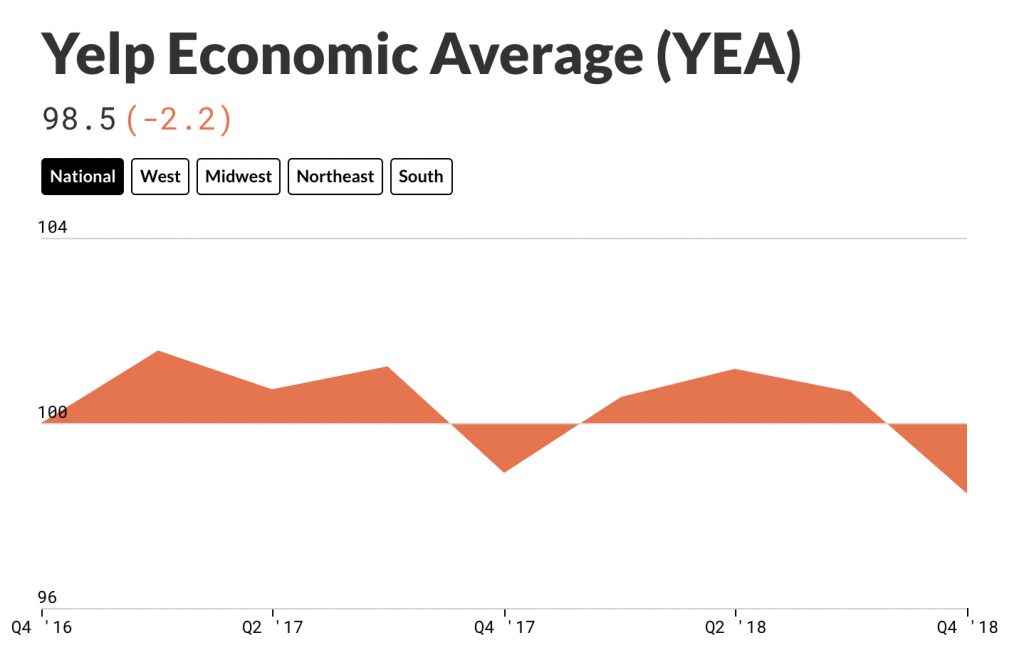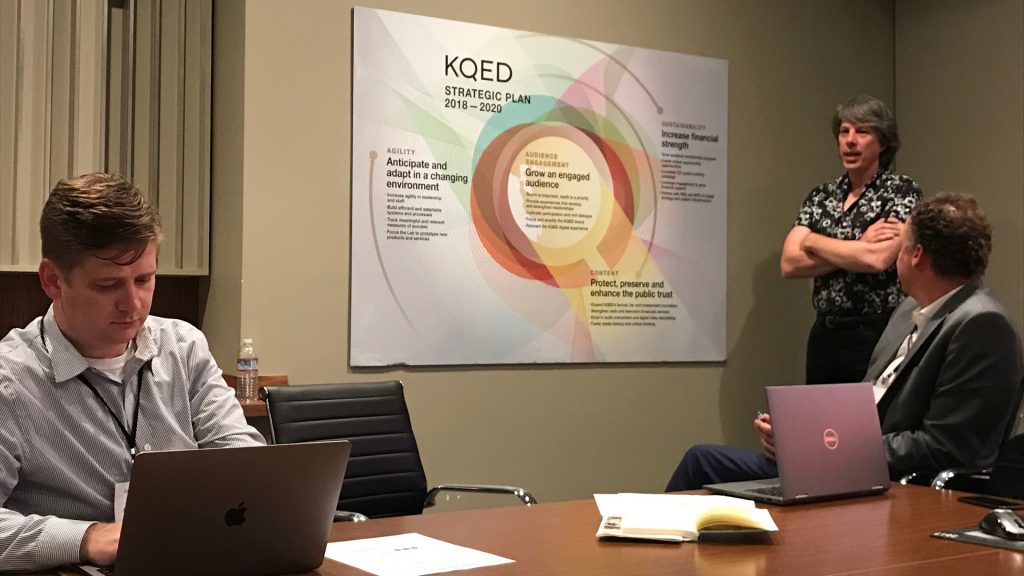
Shiny lobbies. Workplaces that are called “campuses.” Large, open office spaces. Free lunches and snacks! For someone who’s been toiling away in local broadcasting, a visit to the so-called Platform Companies (Facebook, Google, etc.) is like an adult ‘Disneyland’ for news junkies.
Thanks to the Local Media Association, I had just that opportunity. The LMA, which represents small to medium-sized publishers, arranged visits with several of the largest and most influential San Francisco-based platform and technology companies as part of its annual “Innovation Mission.” While in San Francisco, we visited Salesforce, LinkedIn, Facebook, YELP, YouTube and Google, as well as the local PBS station KQED.
There’s a lot that newsrooms could and should learn from what’s made these technology companies successful, sometimes at the direct expense of legacy news business models. Here are seven of my top takeaways from a week in Silicon Valley.
- Build an Aligned Culture
Here’s a fun game for news leaders: Ask members of your team to (separately, without comparing notes) write down in one sentence the newsroom’s mission and target audience. Then, if you dare, go around the room and have folks read their answers aloud. How aligned do you think those answers would be? And, if your newsroom isn’t all on one page on those mission-critical questions, how likely are you to succeed?
Of the companies we visited, Salesforce is probably better known to local media sales teams than their newsroom counterparts. But news leaders could learn a lot about culture alignment from the industry leader in Customer Relationship Management (CRM), ranked by Forbes as the best place to work in America in 2018.
How do you get everyone on the team aligned and moving in the same direction? Salesforce uses what it calls the “V2MOM” process – for Vision, Values, Methods, Obstacles, and Measures – to create alignment throughout the company around goals. Each employee writes a personal V2MOM. The company version is crowd-sourced. Every employee has a chance to give feedback. Even if their suggestions aren’t adopted, they learn in the process WHY a particular goal has been established. Their own V2MOM directly maps their own work to the larger company vision. The company has tens of thousands of employees spread across the country, yet this process results in an organization where everyone knows where the company is going, why, and how their own role connects.
For more, check out this blog by Salesforce CEO Marc Beniof on why building alignment around goals is so critical to organizational success, and how other organizations can apply the V2MOM principles.
2. Be a Listening Organization
Einstein is credited with observing that “We cannot solve our problems with the same level of thinking that created them.” The application to news disruption is clear: Smart leaders will look to leverage all the ideas and input in their organization, especially those younger employees who represent the future news consumer.
I was struck by the flattened organizational structure and mechanisms for direct employee feedback we encountered during our LMA Innovation Mission to the various platform companies. For example, in Facebook’s Mountain View headquarters there’s a large wall covered in sticky notes responding to the provocative question: “Why Aren’t We Talking About…?”
In addition, Josh Mabry, who leads local news partnerships for Facebook, told our group that CEO Mark Zuckerberg still continues a long tradition of holding weekly all-staff, one-hour meetings on Fridays where employees can, in effect, ‘AMA’ (ask Mark anything).

At Salesforce, the method for direct feedback is called AOG: “Airing of Grievances.” It’s an online space where any employee can post a concern, and leaders get notified and can see everything that’s submitted. The company’s V2MOM process, described earlier, is another example, since the company-wide final result includes a public process where all employees can weigh in.
Flattened organizational structures and direct employee feedback paths ensure that everyone’s voice is heard, and they can prevent a leadership ‘echo chamber.’
3. Prioritize Onboarding
Ask a news manager the fastest way to move a newsroom’s culture and habits forward and most will say: by strategic new hires. Yet local broadcasters are notorious for hurried onboarding of new hires.
Honestly, we all understand why. Everyone is SO busy. And when positions aren’t filled, everyone else takes on more. There’s an understandable rush to plug the new hire in to the ‘assembly line’ of daily news production: ‘Thank goodness you’re here, here’s your desk, here’s your logins, hey can you turn a package for the 5p today?’
But there is a profound hidden cost to minimalist onboarding: the missed opportunity to start with ‘First Things’ — to create alignment on goals and culture before an employee gets immersed in the busy-ness of daily news coverage.
Platform companies understand the value of onboarding, and use technology to make it time-efficient, too. For example, Salesforce smartly automates a series of email messages that deliver what new employees need to know – before, during, and after their start date – at the critical moment they need to know it. Then, Salesforce uses data (email open rates, engagement rates/actions) to refine the timing and content of the onboarding messages. They have a similar ‘onboarding’ for employees who are becoming people-managers for the first time.
Automating the onboarding process to set employees up for success: @salesforce uses scheduled messages to help onboard new hires, as well as newly promoted managers. Then uses the data to refine messaging. Smart. #LMAIM pic.twitter.com/yYGstisij9
— Frank Mungeam (@frankwords) June 10, 2019
The Salesforce use of strategically timed informational emails shows it’s possible to make the onboarding process more personalized and effective without requiring more time. Newsrooms could identify those same ‘need to know’ items and sequence a similar set of messages.
Consider the alternative: What does it really say about our priorities — and our future — if newsrooms are ‘too busy’ to onboard new employees well? A newsroom too busy to onboard its employees of the future may not have one.
4. Make the Workspace Work
It’s not fair to compare the shiny work spaces of Silicon Valley with the typical local TV newsroom. Breaking-news pizza is as close as we’re likely to get to the all-you-can-eat free lunch buffet. But even if the profit margins and growth rates are different, there are some transferable lessons about making the work space ‘work.’
Work spaces at the platform companies default to ‘open.’ They place a priority on collaboration. White boards are common. Meeting rooms are busy. Sticky notes are everywhere. Compare this to a typical newsroom with nooks and crannies and compartmentalized areas separating teams. How far is your digital team from producers? From the assignment desk? I’ve participated in several newsrooms that reorganized their spaces intentionally to move from isolation to collaboration, purposely positioning relevant teams nearby to improve communication.
Aesthetics also count. It’s no accident that, when you combine rankings from Glass Door and Forbes, four of these platform companies – Google, Facebook, LinkedIn and Salesforce — ranked in the top ten places to work in 2019.
Local broadcasters aren’t likely to shed their legacy buildings any time soon. However, I’ve had the pleasure of working for and with local TV General Managers who took pride in place, and creatively found frugal ways to make their workplace a more welcoming place, from things as simple as fresh paint and carpeting, to subtle décor upgrades, to the ‘ultimate’ newsroom luxury: free gourmet coffee!
Others have done the cost-benefit analysis, so I’ll merely observe that “giddy” and “news person” aren’t phrases that go together; but I’ve twice seen teams succumb when this single perk was added. Simple upgrades can enrich the newsroom work environment.
5. Move from Audience to “Audiences”
By default, broadcasters were in the ‘Audience’ business. Historically, there were just a few choices and we carved up the audience pie three or four ways. Of course, that world of mass audiences has been entirely upended in the digital age. We could learn a lot from the platform companies about how to think about discrete sets of audiences, plural.
When you think of YELP, what comes to mind? I’d bet it’s as a quick way to find a restaurant or maybe a local service, along with hot takes from local users who’ve left reviews. That’s all true. But spend a day with the folks at YELP, and they’ll educate you that they represent possibly the single largest repository of real-time, local behavior and feedback. YELP could be an interesting partner for news organizations looking to develop data-driven, local stories. The YELP Economic Average is just one example of how news organizations might leverage the actions of audiences captured by this recommendation platform to develop stories both locally and nationally.

Likewise, if you think of LinkedIn only as a place to find or post jobs, you might be missing out on a way to connect with targeted audiences for some of your niche reporting. LinkedIn has become a destination platform for content discovery for professionals in key verticals often covered locally, like health, law, business and education. Newsrooms that used to think of Facebook as their method to ‘broadcast’ their online stories to mass audiences might find that, especially when it involves beat reporting, reporters are more likely to reach their targeted audience in some cases by publishing those stories to the LinkedIn feed.
LinkedIn also now provides metrics so authors (including reporters) can track the reach of their posts. I’ve seen this first-hand. My contributions to the Cronkite News Lab, when shared as links on LinkedIn, are seen and read by the niche, targeted audience of news influencers. LinkedIn is now a viable part of an audience reach and distribution strategy for connecting with specific local audiences.
6. Make Data Actionable
“Audience Engagement” and “data-driven decision making” have become such catch phrases that I fear they have lost their meaning. Discerning leaders may want to challenge any use of either phrase with a follow-up to drill down on ‘what exactly do you mean by that?’ and, especially, ‘how are you measuring that?’
Many newsrooms feel overwhelmed with data points. Which ones matter and truly drive success, and which ones don’t? Platform companies are the pros at harnessing and converting data into smart decisions. At Google for example, they hacked their own data sets to make them more usable for newsrooms. For data dabblers, Google Analytics is so comprehensive it can be overwhelming. The Google News Lab partnered with the data team to develop Google’s News Consumer Insights to make the most important, actionable data more accessible for newsrooms.
The data includes what I’d consider meaty ‘audience engagement’ measures: sessions per user, pages per session, and average session time. These are far more powerful engagement insights than mere ‘likes’ or ‘clicks.’ News Consumer Insights enables a publisher to look at its audience composition and break it down into Casual, Loyal and Brand Lover visitors, and even includes a ‘User Value Score.’ In addition, there are reference points like Benchmarks (how you compare to publishers as a group) and Best in Class (what great performance looks like) for each of the key performance indicators. That’s how to make data actionable.
News Consumer Insights by @google includes sessions/user, pages/session, and avg session time. #LMAIM pic.twitter.com/a9bwxzF5hT
— Frank Mungeam (@frankwords) June 12, 2019
Likewise, broadcasters don’t need to ‘reinvent the wheel’ when it comes to defining how to measure online video success. YouTube has been measuring and refining video recommendation for more than a decade. In the early days, their key success indicator was “video plays.” They abandoned this metric years ago, concluding that “watch time” was a more meaningful metric. Recently, they’ve incorporated other signals, including video completion rate. These signals are much closer to capturing audience satisfaction.
One final lesson, aptly put by Anntao Diaz, who leads the Insights team for Google: Every metric is an imperfect approximation. We’ll never be done trying to get as close as we can to what you are trying to measure, so we should regularly review: Is this metric really the best way to measure what matters to us?
7. Put the Audience at the Center (No, Really)
The one most unifying theme of these successful platform companies is a relentless focus on the audience, their customer. Journalism has historically operated as an inside-out medium. We can thank the easy monopoly of printing presses and broadcast airwaves for that. When publishing was hard and expensive, only the few – a newspaper and a couple of broadcasters – could afford to do it. The publishers decided what was “news”, and the audience had only a binary choice: Consume what was offered, or don’t. Their options were few.
Of course, we are living through the choice revolution. Now, publishing is easy and low-cost. Anyone can do it. The consumer has, if anything, too much choice. The new problem for information consumers is filtering: How to find the signal in all the noise?
The seismic shift for publishers is to adapt to the reality of a consumer-centered information ecosystem. Platform companies have built their businesses by being more nimble at serving specific customer needs, from search (Google) to social (Facebook) to jobs (LinkedIn) to video (YouTube) and local recommendations (YELP.)
“Your margin is my opportunity,” as Amazon CEO Jeff Bezos bluntly put it. “The most important single thing is to focus obsessively on the customer.”
The LMA Innovation Mission to San Francisco-based KQED offered hope that broadcasters can learn and apply these lessons. Chief Digital Officer Tim Olson and his team have studied and incorporated many of the practices of successful Silicon Valley startups. They have a highly integrated, multiplatform newsroom; a dedicated team working on innovation experiments; they try many things, quickly, moving on from those that fail and scaling those that work. Best of all, they literally put the audience at the center of their three-year plan. Heck, they have a three-year plan. And they put it on the wall, where every employee can see it every day.

As Olson notes, change didn’t happen overnight, and there have been missteps along the way. But by keeping the audience at the center of its transformation efforts, KQED has become a model for the kind of change that’s possible for local newsrooms.